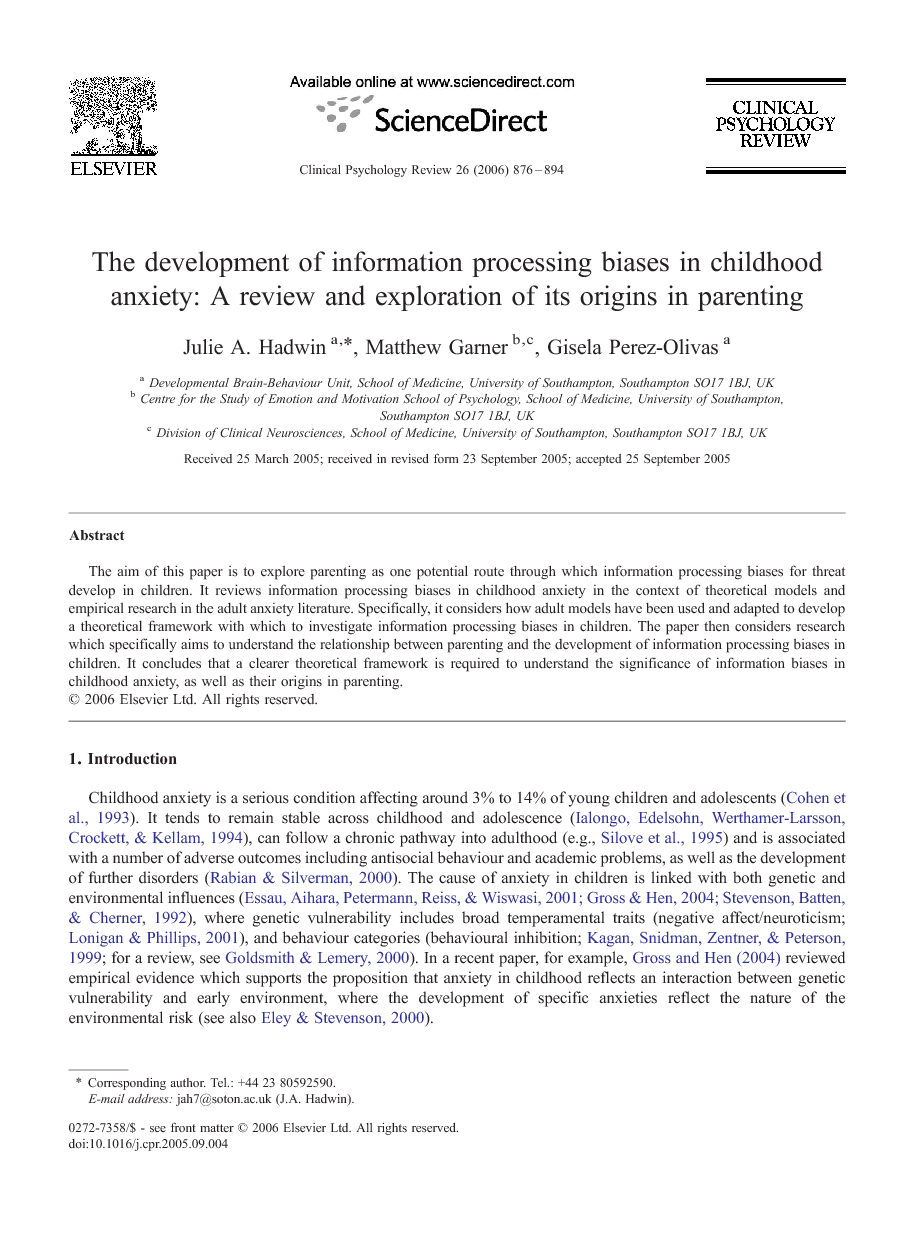Childhood anxiety is a serious condition affecting around 3% to 14% of young children and adolescents (Cohen et al., 1993). It tends to remain stable across childhood and adolescence (Ialongo, Edelsohn, Werthamer-Larsson, Crockett, & Kellam, 1994), can follow a chronic pathway into adulthood (e.g., Silove et al., 1995) and is associated with a number of adverse outcomes including antisocial behaviour and academic problems, as well as the development of further disorders (Rabian & Silverman, 2000). The cause of anxiety in children is linked with both genetic and environmental influences (Essau et al., 2001, Gross and Hen, 2004 and Stevenson et al., 1992), where genetic vulnerability includes broad temperamental traits (negative affect/neuroticism; Lonigan & Phillips, 2001), and behaviour categories (behavioural inhibition; Kagan, Snidman, Zentner, & Peterson, 1999; for a review, see Goldsmith & Lemery, 2000). In a recent paper, for example, Gross and Hen (2004) reviewed empirical evidence which supports the proposition that anxiety in childhood reflects an interaction between genetic vulnerability and early environment, where the development of specific anxieties reflect the nature of the environmental risk (see also Eley & Stevenson, 2000).
Cognitive theory (e.g., Beck, 1976, Williams et al., 1988 and Williams et al., 1997) and empirical research have demonstrated the presence of cognitive or information processing biases towards threatening words and pictures in anxious adults and children (e.g., Mogg et al., 2000 and Taghavi et al., 2000). These information processing biases are proposed to operate throughout several aspects of cognition and to cause (MacLeod, Rutherford, Campbell, Ebsworthy, & Holker, 2002) or maintain (Mogg & Bradley, 1998) anxiety levels. In addition, it is proposed that biases associated with threat are specific to anxious, but not depressed affect in adults and children (Beck & Clark, 1988). Recent theoretical models highlight an interaction between genes and environment with cognitive mechanisms to understand the development of anxiety in children (Craske, 1997, Ginsburg and Schlossberg, 2002, Muris and Merckelbach, 2001 and Rapee, 2001).
Rapee's (2001) model of anxiety, for example, highlights temperamental factors associated with genetic risk (increased arousal, emotionality and cognitive biases). In addition, it proposes a link between environmental factors (parent and peer socialisation), information processing biases for threat and the development of anxiety. In this case, information processing biases mediate parental (and peer) factors and the development of anxiety in children. Developmental research has reliably demonstrated an association between parenting style and childhood anxiety. It has found, for example, that (compared with non-anxious children) anxious children are more likely to have parents who exhibit parenting styles characterised by overcontrol, intrusiveness, overprotection and increased criticism (reviews by Bögels & Brechman-Toussaint, in press; Rabian and Silverman, 2000 and Zahn-Waxler et al., 2000). It is important to recognise that parenting style can reflect qualities of the child, as well as those of the parent (Belsky, 1984) and the developmental context (McCarty & McMahon, 2003). Despite the rapid increase in empirical investigations looking at links between family and childhood anxiety the mechanism through which parenting contributes to its development is, however, unclear (Wood, McLeod, Sigman, Hwang, & Chu, 2003).
The aim of this paper is to explore evidence which highlights links between parenting, information processing biases and childhood anxiety. Developmental research in information processing biases and anxiety has relied heavily on theoretical models and experimental paradigms used in adult research. This review, therefore, considers theory and evidence for information processing biases for threat in anxious adults and looks at the extent to which this literature is supported in developmental research. In addition, it will highlight how recent models have proposed developmental constraints which moderate information processing biases for threat in anxious children (Kindt and Van Den Hout, 2001 and Lonigan et al., 2004). Following models in development (Ginsburg and Schlossberg, 2002 and Rapee, 2001) the paper considers evidence which suggests that parenting serves to increase anxious affect in children. Specifically, it reviews research that has explored whether the link between parenting and childhood anxiety reflects the transmission of a cognitive style from parents to their children, which leads the child to perceive situations as dangerous and threatening (Zahn-Waxler et al., 2000).


